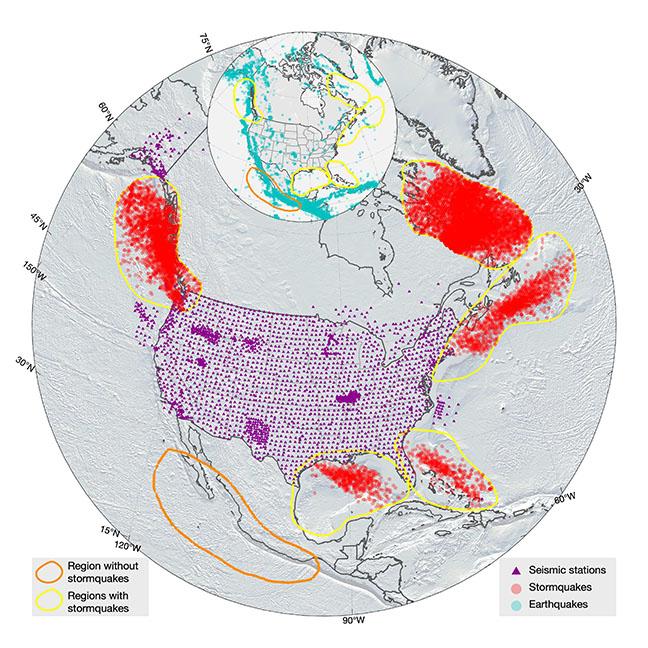Scientists have discovered a new seismic phenomenon originating at the ocean floor

Credit: Fan, McGuire, de Groot-Hedlin, Hedlin, Coats, and Fiedler
SAN DIEGO, December 6, 2019 — Stormquakes are a recently discovered phenomenon characterized by seismic activity originating at the ocean floor due to powerful storms.
Catherine de Groot-Hedlin, a researcher at the Scripps Institution of Oceanography at the University of California, San Diego, was part of the group that first observed stormquakes. She will discuss their properties and meteorological significance during a session at the 178th Meeting of the Acoustical Society of America, which will take place Dec. 2-6, at the Hotel del Coronado in San Diego.
The talk, “Stormquakes: Tracing the path of ocean storms through the solid earth,” will be presented at 9:10 a.m. PT (U.S.) on Friday, Dec. 6, as part of the session on marine seismoacoustics.
Heavy storms, like hurricanes or nor’easters, can create seismic waves as large as magnitude 3.5 quakes. These tremors caused by the effects of storms on the seafloor are what de Groot-Hedlin and her collaborators call stormquakes. An equivalent earthquake would be large enough to generate noticeable indoor shaking.
The track of the storm and the depth of the ocean at its location are key factors in determining whether a stormquake occurs.
“Most hurricanes we studied were strong as they passed north along Georgia to New Jersey but weakened into category 1 or even tropical storms by the time they hit offshore New England,” said de Groot-Hedlin. “Despite this, stormquakes were only detectable off the coast of the New England region and Georges Bank, when the storms were weaker.”
On the other hand, the storm’s intensity does not play a critical role, though it must be strong enough to be able to transfer a certain amount of energy into the ocean. This energy transfer leads to strong pressure zones at the interaction between ocean waves and ocean banks.
“Stormquakes differ from seismic ambient noise in that their sources can be well located near the ocean banks as effective point seismic sources. Seismic noise is random, by contrast,” she said.
The exact mechanisms that lead to the creation of stormquakes remain unknown.
“We’re still in early stages of stormquake research,” de Groot-Hedlin said.
###
De Groot-Hedlin’s presentation 5aAO3, “Stormquakes: Tracing the path of ocean storms through the solid earth,” will be at 9:10 a.m. PT, Friday, Dec. 6, in the Empress room of the Hotel del Coronado in San Diego.
MORE MEETING INFORMATION
USEFUL LINKS
Main meeting website: http://acousticalsociety.
Technical program: https:/
Press Room: http://acoustics.
WORLDWIDE PRESS ROOM
In the coming weeks, ASA’s Worldwide Press Room will be updated with additional tips on dozens of newsworthy stories and with lay language papers, which are 300-500 word summaries of presentations written by scientists for a general audience and accompanied by photos, audio and video. You can visit the site during the meeting at http://acoustics.
PRESS REGISTRATION
We will grant free registration to credentialed journalists and professional freelance journalists. If you are a reporter and would like to attend, contact the AIP Media Line at 301-209-3090. For urgent requests, staff at [email protected] can also help with setting up interviews and obtaining images, sound clips or background information.
LIVE MEDIA WEBCAST
Press briefings will be webcast live from the conference Tuesday, Dec. 3, in Hospitality Suite 3103 of the Hotel del Coronado in San Diego. Register at https:/
ABOUT THE ACOUSTICAL SOCIETY OF AMERICA
The Acoustical Society of America (ASA) is the premier international scientific society in acoustics devoted to the science and technology of sound. Its 7,000 members worldwide represent a broad spectrum of the study of acoustics. ASA publications include The Journal of the Acoustical Society of America (the world’s leading journal on acoustics), Acoustics Today magazine, books, and standards on acoustics. The society also holds two major scientific meetings each year. For more information about ASA, visit our website at http://www.
Media Contact
Larry Frum
[email protected]
301-209-3090




